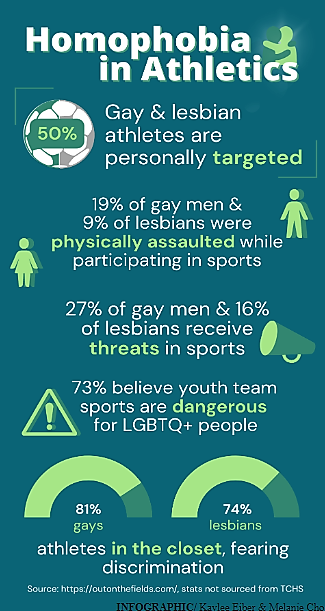
INFOGRAPHIC/ Melanie Cho & Kaylee Eiber
By Ella Chan,
Staff Writer
Imagine that, throughout your life, you played with teams you never felt comfortable in. The brand and definition of your team never made you feel like yourself or a part of a family as it did for your teammates. But if you tried to be open about your inability to fit in with the teams you play with now, you may never get the chance to play in the field of sports ever again due to discriminatory attitudes and legislation.
Sports improve the lives of students, and this is especially true for LGBTQIA+ individuals. According to the Gay, Lesbian and Straight Network, students who participate in sports see improvements in their emotional regulation, fewer symptoms of depression and a decrease in suicidality and hopelessness. For LGBTQIA+ youth, 56% of those on high school sports teams feel a positive sense of belonging in school. Every athlete has the right to experience the community of love and belonging that sports provide.
But for transgender athletes, the field of genderized sports is not a fair one. Since 2020, anti-trans legislation has only increased. GLSEN reports that as of 2021, 25 states had discriminatory legislation restricting trans athletes. In Utah, South Dakota and other states, invasive medical examinations are required for students to participate in any sports. In the current system of segregating athletes by gender identity, these regulations are a violation of transgender and nonbinary students’ rights to bodily autonomy, health, privacy, equality and participation.
Yet, many of them still pass because they are proposed under the guise of protecting cisgendered athletes. For example, a ban against trans-female athletes playing on female sports teams may pass because it is supposed to protect cis-female athletes from being assaulted by a cis-male pretending to be a trans-female or losing opportunities to a trans athlete with biological advantages from the way their body developed differently than cisgendered athletes after puberty.
However, biological advantages already occur within cisgendered athletes. Caster Semenya, a female track-and-field athlete, in comparison to the average female athlete, has higher testosterone levels: a hormone believed to result in larger, stronger bodies.
Michael Phelps, a cisgender male elite swimmer, produces half the amount of lactic acid and has twice the lung capacity as the average male athlete, which could allow him better swimming ability because he may experience less intense muscle fatigue and can stay underwater for longer.
Sports are based around biological capacity and athletic skill. To exclude people for their biology, when the only factor determining athlete categorization is their gender identity, is to contradict the meaning behind competition in the first place.
There are ways by which we can protect cisgendered athletes without passing regulations that hurt all transgender athletes. The majority of assault and abuse of athletes is done by coaches and medical professionals, not transgender athletes joining their teams, so we should focus instead on improving check-ins with athletes and screening of coaches and medical professionals to ensure athletes aren’t being abused. And in the unlikely case that there are cisgendered athletes trying to hurt other athletes by abusing the system of allowing transgender athletes to change teams, it can be dealt with on a case-by-case basis. We shouldn’t hurt all trans athletes for the sake of an unlikely hypothetical.
Every person who loves sport, regardless of gender identity, should be free to don a uniform that suits them, play the sport that they love and form bonds with teammates that will accept them for who they truly are.
